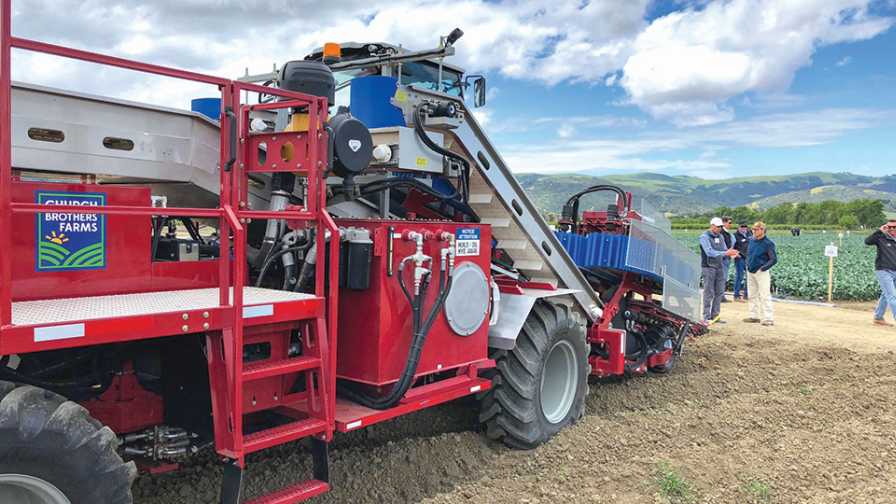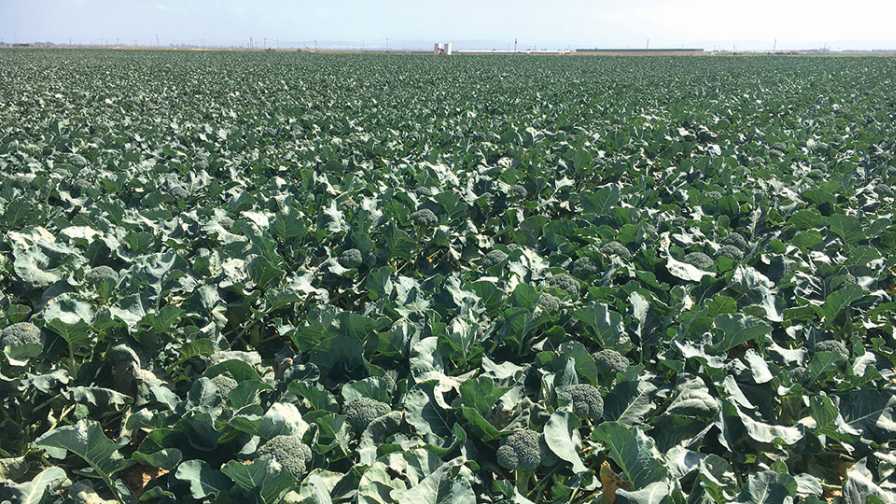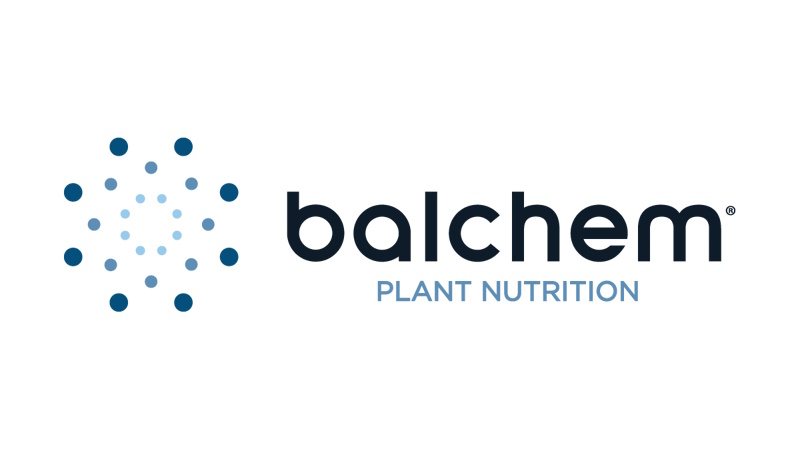Automation in Vegetable Harvesting Picks up the Momentum

Church Brothers Farms in California changed its planting configurations and spacing to accommodate the width of the automated broccoli harvester.
Photo by Richard Smith
A critical labor shortage threatens the ability of leafy green and other cool-season vegetable growers to produce and harvest their crops. What can an operation do to gain some control over the crisis? After all, migrant labor availability is subject to political forces outside of the power of the agricultural community.
However, growers are taking proactive steps to address this issue. They’re teaming with technology companies to develop new automated harvesting technologies and more.
In the Salinas Valley, for example, there has been swift adoption of machines that thin and weed lettuce and other crops. New technologies have also been developed for transplanting (e.g., PlantTape) and irrigating crops (e.g., use of permanent set sprinkler pipe and single-use drip tape).
Widespread Automated Harvester Adoption Is Coming
If the industry could find a way to develop automated harvesting to the point that most growers can use it, it will be a big step forward.
Carrots and potato operations have mechanically harvested for many years. That’s because they can withstand rougher handling and still maintain quality.
Crops like leafy and other cool-season vegetables, however, present challenges for mechanized harvesting because of the delicate nature of the product. As a result, most picking and packing is still being done by hand in order to maintain quality.
Let’s take a look at where we are in developing mechanical harvesting and which issues you should weigh before adopting the technology yourself.
Factors to Consider
The decision to move to mechanical harvest is not straight forward. Here are some practical decision points that interplay and complicate the decision to move toward mechanical harvest:
- Labor availability
- Cost to develop and/or purchase the machines
- Machines speed and efficiency
- Impacts on the final product quality
- Maintenance costs
- Impact on worker satisfaction
- New Technology Means New Growing Methods
An early example was the mechanization of baby lettuce, spring mix, and spinach in the early 2000s. Those early machines used a band saw to cut across the width of a high-density, 80-inch-wide bed and lifted the product to a platform. From there, the machine placed the lettuce into totes used to transport the product to the packing facility.
As we shall also see in a subsequent example, in order to make these harvesters work effectively, growers had to change production practices. They shaped beds with power mulchers to create smooth, uniform beds that allowed cutter bars to operate efficiently. High-quality, baby leaf vegetables required specific plant spacing to assure ideal and uniform leaf sizes, which, in turn, required optimal plant populations and planters to assure that spacing.
Crop Varieties Must Adapt, Too
Just as you’ll need to change cultural practices for mechanical harvesting, you’ll also need to adjust your variety choices.
The processing tomato harvester in the 1960s is a classic example of an automated harvester meshing with the appropriate variety. This machine required varieties that ripened uniformly, stored well in the field, separated from the plant easily, and could withstand handling.
Once breeders developed varieties that worked well with the new machines, automated harvesting of processing tomatoes quickly became the industry standard.
A similar example of this type of synergy between machine and variety is underway in the Salinas Valley. Josh Ruiz, Vice President of Ag Operations at Church Brothers Farms, has been developing an automated broccoli harvester for the past five years. It uses a cutting bar for a once-over harvest.
To improve harvest efficiency, Josh collaborated with Seminis Seed Company to use varieties from their high-rise portfolio (e.g., Eiffel and Hancock) that have broccoli heads higher on the plant than traditional varieties.

Seminis Seed Company collaborated with Church Brothers Farms’ Josh Ruiz, Vice President of Ag Operations, on developing broccoli varieties that work well with automated harvesting equipment.
Photo by Richard Smith
Josh says having the broccoli heads located higher up on the plant helps the machines harvest. But equally important, the varieties have good uniformity, which allows efficient harvest and good yields.
Josh has found that to make a mechanical harvester work, you must be willing to change production practices. For instance, Church Brothers Farms has changed both planting configurations and spacing to accommodate the width of the harvester. Their work on their automated broccoli harvester is not 100% complete, as they continue to refine it and make improvements.
The Quality Challenge
Early harvesters work best on whole-head bulk lettuce destined for salad plants and bagged salad products. They cut all the lettuce on an 80-inch-wide bed, lift the lettuce onto a platform where it is hand sorted and deposited into bins for transport to the processing plant.
The quality standards for bulk lettuce are not as stringent as for fresh market lettuce, and these machines work well. However, the cost, speed, and capacity of the machines are important considerations for their use. Also, although this harvester eliminates the need for people to cut lettuce, you still need labor to sort and core it.
Quality standards for fresh market lettuce are more demanding. And harvesters for this type of product are trickier to develop.
The Italian company Ortomec has developed a harvester for fresh market romaine. Bob Sutton of Sutton Ag in Salinas, CA, has worked with several vegetable companies evaluating the Ortomec 9700 Lattuga (type “Lattuga” on YouTube). He is determining how it can save labor and effectively harvest lettuce.
According to Sutton, issues that companies face when evaluating an automated harvester are the cost of the machine, net savings in labor, and its overall harvest capacity and speed.
A key question is how many machines are needed to satisfy harvesting needs and for addressing breakdowns. A non-selective cutting mechanism that cuts all the lettuce on the bed, like the Ortomec 9700, requires more labor on the platform to sort the product prior to packing.
A machine that uses a selective harvest mechanism (e.g., a mechanical arm) might require less labor for packing. However, it would be more complex and move slower through the field.
These factors make decisions about automating lettuce harvest complex. Understandably, there has not yet been widespread movement to mechanical harvest for fresh market lettuce, although significant progress is being made.
What Could Speed Up Adoption?
There are still some key challenges remaining.
For one, once the harvester lifts the crop to a packing platform, can trimming, bunching, and bagging be automated? Can computer vision improve which product the harvester selects? These are all questions that engineers are working to resolve.
However, beyond these purely technical questions, for automated harvesters to succeed, they must give a return on investment in a reasonable amount of time. Given high development costs for automated harvest machines, there may be opportunities for companies to work together, collaborate, and pool resources.
These technical factors do not exist in a vacuum. Outside forces could also accelerate industry-wide adoption of automated harvesting.
If, for example, the U.S. decided to suspend the H-2A temporary agricultural worker program, the impetus for automated harvesting would increase dramatically. Likewise, if a new machine could make the work easier (especially important to older workers), or increase worker satisfaction and retention, these could be important factors tipping the balance toward mechanization.
Clearly, we need all technical and financial ideas to adjust to the labor crunch. And we keep growers in the business of providing cool-season vegetables to a demanding marketplace.










